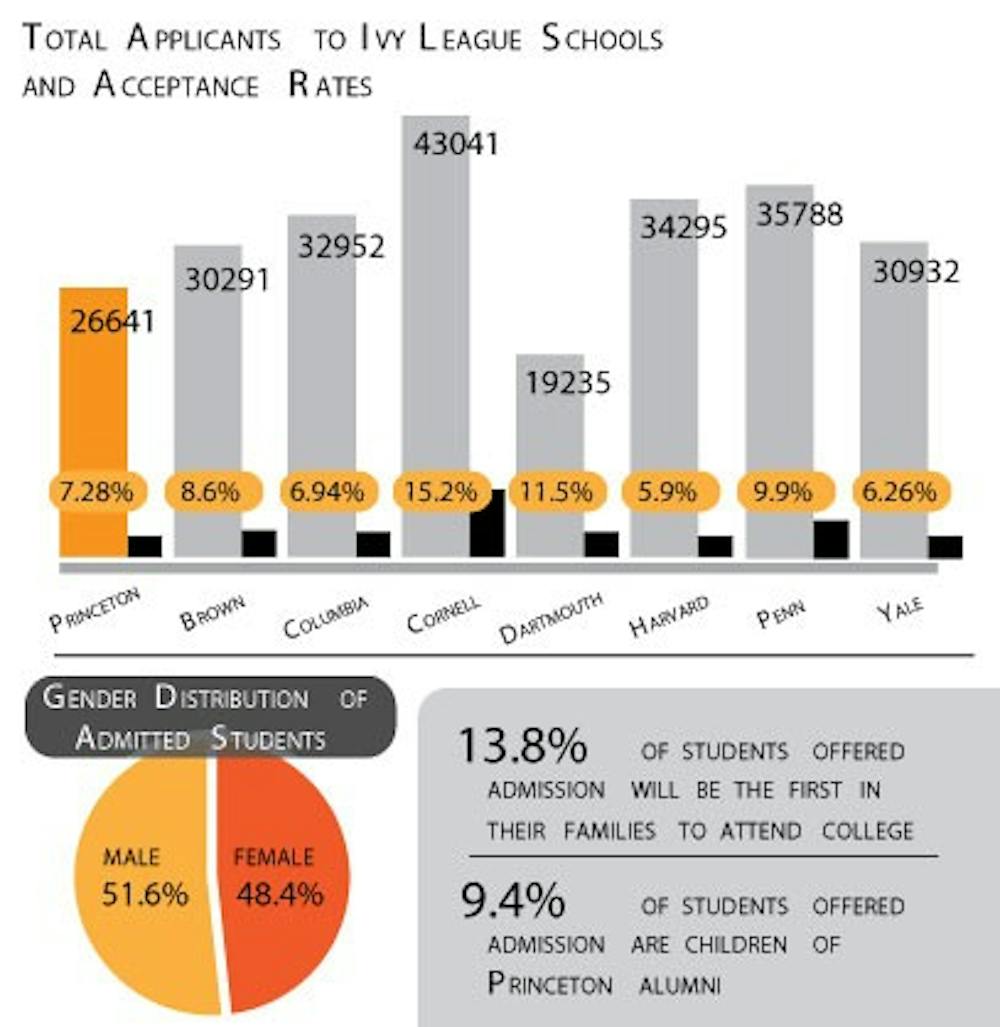The University has offered admission to 1,939 students, or 7.28 percent, of the 26,641 applicants for the Class of 2018, making this the most selective admission year the University has seen to date. This year marks a one-hundredth increase in selectivity from last year’s record-low 7.29 percent acceptance rate.
This year’s number of applicants is also among the highest the University has seen, increasing from last year’s number of 26,498. The highest number of applicants was 27,189, set by the Class of 2015, the last year before the University reinstated an Early Action admission round.
The University's undergraduate admission office mailed letters to students admitted in the regular decision applicant pool, but students were able to view their decisions in an online portal since Thursday at 5 p.m. EST. Of the 1,939 admitted students, 714 were admitted through the early action applications back in December.The class size is expected to be 1,308 students for the Class of 2018, a slight increase over last year’s estimate of 1,290 because the University has determined itself to have a slightly higher capacity than it previously expected.
Dean of Admission Janet Rapelye expressed uncertainty as to how the negative publicity that the University has received for the meningitis outbreak will impact yield, but said that the change in University leadership under President Christopher Eisgruber ’83 could impact yield positively.
“It’s exciting having new leadership, that may be important for some students,” Rapelye said in an interview with The Daily Princetonian.
Rapelye also discussed the University’s objective to attract more low-income students.
“We are hoping we’ll have more low-income students,” Rapelye said. “We took the research that [economist] Caroline Hoxby did quite seriously. We have admitted more students who participated in the LEDA program and who participated in QuestBridge.”
Leadership Enterprise for a Diverse America and QuestBridge are both programs designed to increase college opportunities for low-income students. Rapelye was referring to Hoxby’s research on low-income students and college matriculation. She explained that Hoxby’s research indicates there are more high-achieving low-income students than perhaps originally thought and tries to identify solutions for increasing college opportunities for these groups.
Of the students offered admission, 51.6 percent are men and 48.4 percent are women, and 48.3 percent have identified themselves as people of color. Of these, 10.5 percent are African American, 10.4 percent are Hispanic, less than 1 percent are Native American/Alaskan Native, 23.4 percent are Asian and 4 percent identify as multi-racial. The percentage of admitted students who are men has increased slightly over last year’s 50.2 percent.
Students accepted to the Class of 2018 come from 48 states in addition to Washington, D.C. and Puerto Rico. The only states not represented are Nebraska and North Dakota. International students comprise 11.4 percent of the accepted students, representing 68 countries that include Iceland, Ghana, Jamaica, Rwanda, Taiwan and Paraguay. Applicants last year represented 47 states, while the percentage of international students was exactly the same.
“Of course we have no quotas and do a holistic review,” Rapelye said, adding that this year’s applicant pool was nearly identical to the one last year.

Sixty-one percent of the admitted students are from public schools and 13.8 percent will be the first in their families to attend college, statistics almost identical to last year’s class, of which 61 percent came from public schools and 13.9 percent were first-generation students.
Legacy students, or sons and daughters of University alumni, comprise 9.4 percent of the admitted class.
Of the admitted students, 25.3 percent specified an interest in studying engineering at Princeton, 43 percent of whom are women. Rapelye noted that this statistic is a new record for the University.
1,141 students were offered a spot on the waitlist this year, a decrease from the 1,395 who were offered a spot on the waitlist last year. Rapelye noted that it is often difficult to predict how many students will be offered admission off the wait list. Although roughly 30 students were taken off the waitlist last year, in the past several years the number of students offered admission off the waitlist has ranged from 165 to none.
“With the class of 2018, we are thrilled with the quality,” Rapelye said. “They are outstanding in every way.”








